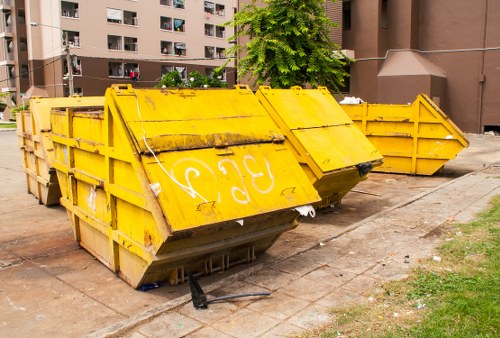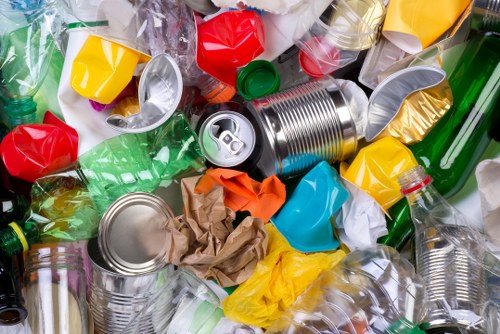Waste Disposal Woodlands: Protecting Our Natural Heritage

Introduction to Waste Disposal in Woodlands
Waste disposal in woodlands is a critical issue that affects both the environment and the health of our forests. Proper management of waste is essential to preserve these natural areas for future generations. In this article, we will explore the various aspects of waste disposal in woodlands, the challenges faced, and the best practices for maintaining a clean and healthy environment.
Woodlands are home to a diverse range of flora and fauna, making them vital ecosystems. However, they are increasingly threatened by improper waste disposal practices. From littering to industrial waste, the impact on these areas can be devastating.
Understanding the importance of waste management in woodlands helps in developing strategies to mitigate negative effects. This article aims to provide comprehensive information on how to handle waste disposal effectively in these natural settings.

Types of Waste Commonly Found in Woodlands
1. Litter and Household Waste
One of the most common types of waste in woodlands is litter. This includes plastic bottles, food wrappers, and other household items that visitors leave behind. Litter not only mars the natural beauty of woodlands but also poses risks to wildlife.
2. Hazardous Waste
Hazardous waste includes chemicals, batteries, and other materials that can be harmful to both the environment and living organisms. Improper disposal of these items can lead to soil and water contamination.
3. Organic Waste
Organic waste, such as food scraps and plant matter, can decompose naturally. However, excessive amounts can disrupt the nutrient balance in woodland soils and affect plant growth.

Impact of Improper Waste Disposal
Improper waste disposal in woodlands has several adverse effects. It can harm wildlife, degrade natural habitats, and contribute to pollution. Additionally, it can lead to the spread of invasive species, which compete with native plants and animals.
Wildlife can ingest or become entangled in litter, leading to injury or death. Hazardous materials can poison animals and plants, disrupting the ecosystem. Furthermore, waste can attract pests, which may carry diseases and further harm the environment.
The aesthetic value of woodlands also diminishes with increased waste, making these areas less appealing for visitors. This can reduce public support for conservation efforts and funding.

Best Practices for Waste Disposal in Woodlands
1. Reduce, Reuse, Recycle
Adopting the principles of reduce, reuse, and recycle can significantly minimize waste in woodlands. Visitors should be encouraged to bring reusable containers and avoid single-use plastics.
2. Provide Adequate Waste Disposal Facilities
Installing sufficient trash bins and recycling stations in woodland areas helps manage waste effectively. Regular maintenance and emptying of these facilities are crucial to prevent overflow and littering.
3. Educate the Public
Raising awareness about the importance of proper waste disposal can lead to more responsible behavior among visitors. Educational programs and signage can inform the public about the impact of their actions on the environment.
4. Implement Waste Collection Programs
Organizing regular waste collection drives and clean-up events can help maintain the cleanliness of woodlands. These programs engage the community and foster a sense of ownership and responsibility towards natural areas.
5. Use Eco-friendly Products
Encouraging the use of eco-friendly products reduces the amount of harmful waste generated. Biodegradable materials and environmentally safe products have less impact on the woodland ecosystem.

Innovative Solutions for Waste Management
1. Composting
Composting organic waste can reduce the amount of garbage sent to landfills and provide valuable nutrients for woodland plants. Community composting programs can be implemented to manage biodegradable waste effectively.
2. Waste-to-Energy Technologies
Advanced technologies that convert waste into energy offer a sustainable solution to waste disposal. These methods can reduce the volume of waste and provide clean energy for local communities.
3. Bioremediation
Bioremediation uses microorganisms to break down hazardous waste, restoring contaminated soil and water. This technique is effective in cleaning up polluted areas within woodlands.
4. Smart Waste Management Systems
Utilizing technology like sensors and GPS can improve waste collection efficiency. Smart systems can monitor waste levels in real-time and optimize collection routes, reducing costs and environmental impact.
Local Relevance: Woodlands Near You
Understanding the local woodlands and their proximity is essential for effective waste management. Here are some of the closest woodlands to Woodlands, each with unique features relevant to waste disposal:
- Woodlands Park: Located just 5 miles from Woodlands, it offers extensive trails and requires regular waste collection due to high visitor turnover.
- Greenwood Forest: Situated 7 miles away, Greenwood is known for its diverse wildlife, making waste management crucial to protect its ecosystems.
- Maple Grove: 10 miles from Woodlands, Maple Grove has several picnic areas that generate significant organic waste.
- Pine Ridge: At 12 miles distance, Pine Ridge faces challenges with hazardous waste from nearby recreational activities.
- Sunset Woods: 8 miles away, Sunset Woods is a popular spot for camping, necessitating effective waste disposal solutions.
- Riverbank Woodlands: Located 6 miles from Woodlands, this area has water bodies that are sensitive to pollution from improper waste disposal.
- Hilltop Forest: 9 miles away, Hilltop has several hiking trails that require adequate waste facilities to manage litter.
- Shadow Valley: 11 miles from Woodlands, Shadow Valley is home to endangered species, making waste management critical to their survival.
- Oakwood: At 4 miles distance, Oakwood has dense vegetation that can be easily harmed by litter and waste.
- Birch Meadows: 13 miles from Woodlands, Birch Meadows faces issues with organic waste accumulation affecting soil health.
- Cedar Springs: 14 miles away, Cedar Springs includes wetlands that are vulnerable to contamination from hazardous waste.
- Spruce View: Located 15 miles from Woodlands, Spruce View requires innovative waste disposal solutions to handle high visitor numbers.
Community Involvement in Waste Management
Engaging the community is essential for effective waste disposal in woodlands. When people take ownership of their local environment, they are more likely to act responsibly and support conservation efforts.
Local organizations and volunteer groups can play a significant role in organizing clean-up events and promoting waste management initiatives. Schools and educational institutions can incorporate waste management education into their curricula to instill responsible habits in younger generations.
Collaboration between government agencies, community groups, and businesses can lead to the development of comprehensive waste management plans tailored to the specific needs of each woodland area.
Government Regulations and Policies
Government regulations play a crucial role in ensuring proper waste disposal in woodlands. Policies must be enforced to prevent illegal dumping and promote sustainable waste management practices.
1. Enforcement of Anti-dumping Laws
Strict enforcement of laws against illegal dumping is necessary to deter individuals and organizations from disposing of waste improperly. Penalties and fines can act as deterrents.
2. Funding for Waste Management Programs
Allocating funds for waste management infrastructure, such as trash bins and recycling facilities, ensures that woodlands have the necessary resources to maintain cleanliness.
3. Environmental Impact Assessments
Conducting regular environmental impact assessments helps identify areas where waste disposal issues are most prevalent and directs efforts to mitigate these problems.
4. Incentives for Sustainable Practices
Providing incentives for businesses and individuals to adopt sustainable waste management practices encourages long-term commitment to environmental protection.
Technological Advancements in Waste Management
Technology offers innovative solutions to tackle waste disposal challenges in woodlands. From smart bins to advanced recycling systems, technological advancements enhance the efficiency and effectiveness of waste management strategies.
1. Smart Bins
Smart bins equipped with sensors can monitor waste levels in real-time, allowing for timely collection and preventing overflow. They can also provide data on waste patterns, aiding in better management decisions.
2. Mobile Apps for Waste Reporting
Mobile applications enable visitors to report waste disposal issues, such as overflowing bins or illegal dumping, facilitating quick responses from authorities.
3. Automated Recycling Systems
Automated systems can sort and process recyclables more efficiently, reducing the manpower required and increasing recycling rates in woodland areas.
4. Renewable Energy Solutions
Integrating renewable energy sources, like solar-powered waste processing facilities, ensures that waste management operations are sustainable and environmentally friendly.
Challenges in Waste Disposal in Woodlands
Despite the best efforts, several challenges hinder effective waste disposal in woodlands. Understanding these obstacles is the first step toward overcoming them.
1. Limited Accessibility
Remote woodland areas often lack easy access to waste disposal facilities, making it difficult to manage and remove waste efficiently.
2. High Cost of Waste Management
Implementing and maintaining waste management systems can be expensive, especially in large or heavily visited woodlands.
3. Public Apathy
A lack of awareness or interest among the public can lead to irresponsible waste disposal behavior, undermining conservation efforts.
4. Vandalism and Illegal Dumping
Vandalism and illegal dumping are persistent problems that can damage waste management infrastructure and pose environmental hazards.
5. Seasonal Variations
During peak seasons, woodlands experience a surge in visitors, resulting in increased waste generation that existing systems may struggle to handle.
Future Directions in Waste Management for Woodlands
Looking ahead, the focus should be on sustainable and innovative approaches to waste management in woodlands. Emphasizing community involvement, technological integration, and policy support will be key to creating lasting solutions.
Research into new materials and methods can lead to more efficient waste processing and reduction techniques. Additionally, fostering a culture of responsibility and stewardship among the public will ensure that woodlands remain pristine and protected.
Investing in education and outreach programs will empower individuals to make informed decisions about waste disposal, further enhancing the effectiveness of waste management efforts.
1. Embracing Sustainability
Adopting sustainable practices ensures that waste management efforts do not harm the environment. This includes using eco-friendly materials and minimizing the carbon footprint of waste disposal processes.
2. Enhancing Collaboration
Strengthening collaboration between various stakeholders, including government bodies, non-profits, and local communities, can lead to more comprehensive and effective waste management strategies.
3. Promoting Innovation
Encouraging innovation in waste management technologies can address current challenges and provide new solutions to persistent problems.
Conclusion
Waste disposal in woodlands is a pressing issue that requires immediate and sustained attention. By understanding the types of waste, recognizing the impacts of improper disposal, and implementing best practices, we can protect these vital ecosystems. Community involvement, government support, and technological advancements will play significant roles in creating a cleaner and healthier environment for our woodlands.
Preserving woodlands through effective waste management not only benefits the environment but also enhances the quality of life for all who enjoy these natural spaces. It is a collective responsibility to ensure that our forests remain unspoiled for generations to come.
Frequently Asked Questions
1. What are the main types of waste found in woodlands?
The main types of waste found in woodlands include litter and household waste, hazardous waste, and organic waste. Each type has different impacts on the environment and requires specific management strategies.
2. How can the community help in waste disposal efforts in woodlands?
The community can help by participating in clean-up events, using designated waste disposal facilities, following the principles of reduce, reuse, and recycle, and spreading awareness about the importance of proper waste management.
3. What role does the government play in managing waste in woodlands?
The government enforces anti-dumping laws, provides funding for waste management programs, conducts environmental impact assessments, and offers incentives for sustainable practices to ensure effective waste disposal in woodlands.
4. What are some innovative technologies used in waste management for woodlands?
Innovative technologies include smart bins with sensors, mobile apps for waste reporting, automated recycling systems, and renewable energy solutions like solar-powered waste processing facilities. These technologies enhance the efficiency and effectiveness of waste management.
5. Why is proper waste disposal important for the health of woodlands?
Proper waste disposal is crucial for protecting wildlife, preserving natural habitats, preventing pollution, and maintaining the aesthetic and ecological value of woodlands. It ensures that these ecosystems remain healthy and sustainable for future generations.